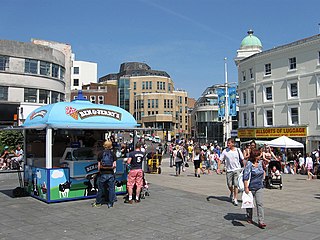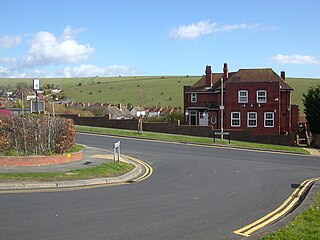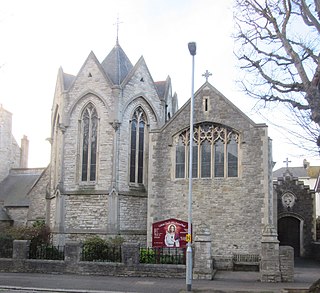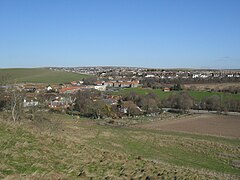
Brighton is a seaside resort and one of the two main areas of the city of Brighton and Hove in the county of East Sussex, England. It is located 47 mi (76 km) south of London. Archaeological evidence of settlement in the area dates back to the Bronze Age, Roman and Anglo-Saxon periods. The ancient settlement of "Brighthelmstone" was documented in the Domesday Book (1086). The town's importance grew in the Middle Ages as the Old Town developed, but it languished in the early modern period, affected by foreign attacks, storms, a suffering economy and a declining population. Brighton began to attract more visitors following improved road transport to London and becoming a boarding point for boats travelling to France. The town also developed in popularity as a health resort for sea bathing as a purported cure for illnesses.

Brighton and Hove is unitary authority with city status in East Sussex, England. There are multiple villages alongside the seaside resorts of Brighton and Hove in the district. It is administered by Brighton and Hove City Council, which is currently under Labour majority control.

Rottingdean is a village in the city of Brighton and Hove, on the south coast of England. It borders the villages of Saltdean, Ovingdean and Woodingdean, and has a historic centre, often the subject of picture postcards.

Woodingdean is an eastern suburb of the city of Brighton and Hove, East Sussex, separated from the main part of the city by downland and the Brighton Racecourse. The name Woodingdean came from Woodendean Farm which was situated in the south end of what is now Ovingdean.

Hangleton is a residential suburb and unparished area of Brighton and Hove, in the ceremonial county of East Sussex, England. The area was developed in the 1930s after it was incorporated into the borough of Hove, but has ancient origins: its parish church was founded in the 11th century and retains 12th-century fabric, and the medieval manor house is Hove's oldest secular building. The village became depopulated in the medieval era and the church fell into ruins, and the population in the isolated hilltop parish only reached 100 in the early 20th century; but rapid 20th-century development resulted in more than 6,000 people living in Hangleton in 1951 and over 9,000 in 1961. By 2013 the population exceeded 14,000.

Charles Eamer Kempe was a British Victorian era designer and manufacturer of stained glass. His studios produced over 4,000 windows and also designs for altars and altar frontals, furniture and furnishings, lichgates and memorials that helped to define a later nineteenth-century Anglican style. The list of English cathedrals containing examples of his work includes: Chester, Gloucester, Hereford, Lichfield, Wells, Winchester and York. Kempe's networks of patrons and influence stretched from the Royal Family and the Church of England hierarchy to the literary and artistic beau monde.

St Andrew's Church is an Anglican church in Church Road, Hove, in the English city of Brighton and Hove. It is usually referred to as St Andrew (Old Church) to distinguish it from another St Andrew's Church in Waterloo Street, elsewhere in Hove. It served as Hove's parish church for several centuries until 1892, although the building was in a state of near-ruin until Hove began to grow from an isolated village to a popular residential area in the early 19th century.

Aldrington is an area of Hove, in the city of Brighton and Hove in the ceremonial county of East Sussex, England. It was formerly a civil parish. For centuries it was meadow land along the English Channel stretching west from the old village of Hove to the old mouth of the River Adur, and it is now a prosperous residential area integrated within Hove.

St Margaret's Church is an Anglican church in the village of Rottingdean, in the city of Brighton and Hove, England. It is the parish church of Rottingdean, which became part of the former Borough of Brighton in 1928. Parts of the structure date from the 13th century, and it is a Grade II* listed building.

Stanmer Church is a former Anglican church in Stanmer village, on the northeastern edge of the English city of Brighton and Hove. The ancient village stands within Stanmer Park, the former private estate of the Earl of Chichester, which the Brighton Corporation acquired for the benefit of Brighton's citizens after the Second World War. The church and a stately home, Stanmer House, stand outside the village but within the park's boundaries. The church, which was declared redundant in 2008, has been listed at Grade II by English Heritage for its architectural and historical importance.

St Wulfran's Church, dedicated to the 7th-century French archbishop Wulfram of Sens, is an Anglican church in Ovingdean, a rural village now within the English city of Brighton and Hove. Parts of the structure date from the early 12th century, and the church is listed at Grade I, a designation used for buildings "of outstanding architectural or historic interest".

Ovingdean Hall School (OHS) was a special day and boarding secondary school for the severely and profoundly deaf children and young people including those with additional special needs. It closed in July 2010.

St Peter's Church is a Roman Catholic church in the Aldrington area of Hove, part of the English city of Brighton and Hove. It is one of three Roman Catholic churches in Hove and one of eleven in the wider city area. Built between 1912 and 1915 in a red-brick Romanesque style, its tall campanile forms a local landmark. It has been listed at Grade II by English Heritage in view of its architectural importance.

St Mary Magdalen's Church is a Roman Catholic church in the Montpelier area of Brighton, part of the English city of Brighton and Hove. Dedicated to Jesus' companion Mary Magdalene, it is one of six Roman Catholic churches in Brighton and one of eleven in the city area. Built by ecclesiastical architect Gilbert Blount in a 13th-century Gothic style to serve the rapidly expanding residential area on the border of Brighton and Hove, it has been listed at Grade II by English Heritage in view of its architectural importance. An adjacent presbytery and parish hall have been listed separately at Grade II.

The Church of the Sacred Heart is a Roman Catholic church in Hove, part of the English city of Brighton and Hove. It is the oldest of Hove's three Roman Catholic churches, and one of eleven in the city area. It has been designated a Grade II Listed building.

Ovingdean Grange is a Grade II listed manor house situated on the south coast of England in the village of Ovingdean, east of Brighton. One of the oldest and most historical residences in Brighton, it gave its name to the novel Ovingdean Grange by the popular 19th-century writer William Harrison Ainsworth.

Wykeham Terrace is a row of 12 early 19th-century houses in central Brighton, part of the English city of Brighton and Hove. The Tudor-Gothic building, attributed to prominent local architect Amon Henry Wilds, is built into the hillside below the churchyard of Brighton's ancient parish church. Uses since its completion in 1830 have included a home for former prostitutes and a base for the Territorial Army, but the terrace is now exclusively residential again. Its "charming" architecture is unusual in Brighton, whose 19th-century buildings are predominantly in the Regency style. English Heritage has listed the terrace at Grade II for its architectural and historical importance.

The English coastal city of Brighton and Hove, made up of the formerly separate Boroughs of Brighton and Hove in East Sussex, has a wide range of cemeteries throughout its urban area. Many were established in the mid-19th century, a time in which the Victorian "cult of death" encouraged extravagant, expensive memorials set in carefully cultivated landscapes which were even recommended as tourist attractions. Some of the largest, such as the Extra Mural Cemetery and the Brighton and Preston Cemetery, were set in particularly impressive natural landscapes. Brighton and Hove City Council, the local authority responsible for public services in the city, manages seven cemeteries, one of which also has the city's main crematorium. An eighth cemetery and a second crematorium are owned by a private company. Many cemeteries are full and no longer accept new burials. The council maintains administrative offices and a mortuary at the Woodvale Cemetery, and employs a coroner and support staff.




















